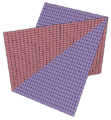Plane (mathematics) facts for kids
A plane is a perfectly flat surface that goes on forever in all directions. Imagine the ceiling of your room, but picture it stretching out endlessly in every direction. A plane has two dimensions: length and width. All planes are flat. If a surface is not flat, it is called a curved surface.
The tool called a plane is used to make surfaces flat and level, just like the mathematical idea of a plane. That's where the name comes from!
In geometry, a plane is made up of an infinite number of lines or points. It has no depth.
A plane figure is a part of a plane. We often name these figures using capital letters (like A, B, C, etc.) placed at their corners.
Mathematicians describe how two planes can be related:
- Parallel means they never meet, no matter how far they extend.
- Concurrent means they meet and cross each other, forming a line where they meet.
- Coincident means they are actually the exact same plane, just described in different ways.
What is a Plane in Math?
In mathematics, a plane is a basic two-dimensional object. Think of it like a flat, endless sheet of paper. There are different ways to define a plane, but they all mean the same thing in Euclidean geometry. These definitions can also be used to describe objects in other areas of math. For example, a shadow is a two-dimensional shape in our three-dimensional world.
Sometimes, in math areas like plane geometry or 2D computer graphics, the entire space you are working in is just one single plane. In these cases, we often say "the plane." Many important tasks in geometry, trigonometry, and graphing are done in this two-dimensional space, or in other words, on the plane.
How Do We Define a Plane?
In Euclidean geometry, a plane is a surface where if you pick any three different points on it, the surface will also contain all the straight lines that connect any two of those points.
We can use a Cartesian coordinate system on a plane. This system helps us give every point on the plane a unique address, which is a pair of numbers called its coordinates.
Within any Euclidean space, a plane is clearly defined by any of these combinations:
- Three points that do not lie on the same line.
- A line and a point that is not on that line.
- Two different lines that cross each other.
- Two different lines that are parallel to each other.
- A vector that is normal (at a right angle) to the plane, and a distance from the origin (the starting point of the coordinate system).
Related Ideas
Images for kids
See also
 In Spanish: Bidimensional para niños
In Spanish: Bidimensional para niños



